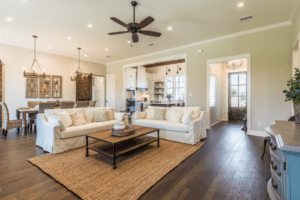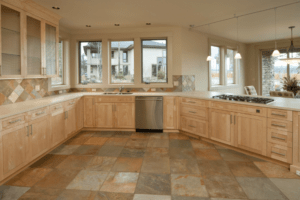The Best Types of Flooring to Add to a Desert Home

Living in a desert environment like the Coachella Valley comes with its unique set of challenges, especially when it comes to choosing the right flooring for your home. The intense heat, dry air, and dust can be harsh on certain types of floors. Therefore, it’s essential to choose a material that can withstand these conditions while also enhancing the beauty of your home. Here, we delve into the best types of flooring to add to a desert home.
What Kind of Flooring is Best in the Desert?
The key to selecting the perfect flooring for desert homes lies in understanding the climate. In the desert, temperatures can soar during the day and drop significantly at night. This fluctuation can cause some flooring materials to expand and contract, leading to damage over time.
Among the top choices for desert homes are:
- Tile Flooring: Tiles, particularly ceramic and porcelain, are excellent options for desert homes. These materials can withstand the harsh desert conditions, thanks to their durability and resistance to heat. Additionally, tile floors are easy to clean, which is beneficial in an environment that is prone to dust.
- Concrete Flooring: This type of flooring is ideal for desert climates due to its thermal mass properties. Concrete floors can absorb heat during the day and then gradually release it as the temperature drops at night. Furthermore, concrete is incredibly durable and requires minimal maintenance.
- Natural Stone Flooring: Natural stone floors, such as slate or travertine, are an attractive choice for desert homes. These materials are naturally resistant to heat and can add a touch of elegance to any space. However, they do require sealing to prevent damage from dust and sand.
- Vinyl Plank Flooring: Vinyl planks are a more affordable alternative to natural wood. They are resistant to temperature fluctuations, making them a suitable choice for desert homes. Vinyl planks are also easy to clean, and they come in a variety of styles to match any décor.
- Cork Flooring: Though not as common, cork flooring is an excellent choice for desert environments. It’s a natural thermal insulator, keeping your home cool during the day and warm at night. Plus, it’s eco-friendly and provides a comfortable, soft surface underfoot.
- Luxury Vinyl: Luxury vinyl is another excellent choice for desert homes. It can mimic the look of natural wood or stone without the high maintenance requirements.
- Engineered Wood: Engineered wood flooring is more stable than solid hardwood, making it a good option for desert climates. It provides the warmth and beauty of wood without the risk of warping or cracking.
What is the Best Flooring for the Desert Climate?
The desert climate is characterized by hot days and cool nights, along with low humidity levels. Given these conditions, the best flooring options are those that can handle temperature fluctuations and resist dust and sand.
Stone flooring, such as natural stone, is a popular choice because of its durability and resistance to heat. Similarly, tile flooring, including glazed tiles, can handle the heat and are easy to clean.
Luxury vinyl, with its durability and wide range of design options, is also a good choice. It’s especially beneficial in rooms where moisture might be a concern, such as kitchens and bathrooms.
What is the Best Wood Flooring for the Desert?
While traditional hardwood can be a challenge in desert climates due to its sensitivity to humidity and temperature changes, engineered wood flooring offers a viable solution. It’s designed with multiple layers of wood, providing stability and reducing the risk of warping or cracking.
However, if you prefer the look and feel of real wood, consider using a humidifier to maintain the right moisture level in your home. This can help prevent your hardwood floors from drying out and cracking.
What is the Best Flooring for the Coachella Valley Heat?
The Coachella Valley is known for its scorching summers, with temperatures often exceeding 100 degrees Fahrenheit. As such, homeowners need flooring that can withstand this extreme heat.
Stone and tile flooring are excellent choices for the Coachella Valley heat. They’re durable, easy to maintain, and can handle the hot temperatures. Additionally, they stay relatively cool underfoot, providing a comfortable surface to walk on even in the hottest weather.
For those who prefer the look of wood, engineered wood flooring is a good option. It’s designed to handle temperature changes better than traditional hardwood.
Are Wood Floors Good in the Desert?
Wood floors can be a beautiful addition to any desert home, but they do require some extra care. Traditional hardwood can warp and crack in the arid desert climate. However, engineered wood flooring is a more stable option that can withstand the harsh conditions.

If you opt for wood floors, it’s important to keep them clean and free of sand and dust, which can scratch the surface. Regular maintenance, including using a humidifier to prevent the wood from drying out, can also help keep your floors looking their best.
What Flooring Absorbs the Most Heat?
Darker floors tend to absorb more heat than lighter ones. Therefore, if you’re looking for flooring that stays cool in the desert heat, you might want to consider lighter shades. Stone and tile flooring, especially in lighter colors, are good options as they don’t absorb as much heat as darker materials.
Is Vinyl Plank Flooring Good in Coachella Valley?
Yes, vinyl plank flooring is a good choice for homes in Coachella Valley. It’s durable, easy to clean, and can handle the heat and dust common in the desert. Plus, vinyl plank flooring can mimic the look of natural wood or stone, providing a stylish look without the high maintenance requirements.
Which Floor is Warmer: Vinyl or Laminate?
Both vinyl and laminate flooring can provide a warm and comfortable surface underfoot. However, vinyl tends to be slightly warmer to the touch than laminate. It’s also more resistant to temperature changes, making it a good choice for desert homes.
What Flooring is Best for Temperature Changes?
Flooring materials that can handle temperature changes well include stone, tile, and luxury vinyl. These materials are durable and resistant to expansion and contraction caused by temperature fluctuations.
Why Do Homes in Coachella Valley Have Tile Floors?
Tile floors are a common choice in Coachella Valley homes due to their durability and ease of maintenance. They’re resistant to heat and can handle the dust and sand that often find their way into desert homes. Plus, tiles stay cool underfoot, making them comfortable to walk on even in the hot summer months.

Is Vinyl Flooring Good for Hot Climates?
Yes, vinyl flooring is an excellent choice for hot climates. It’s durable, easy to clean, and resistant to temperature changes. Plus, it provides a comfortable surface underfoot and comes in a wide range of styles and designs.
Can Vinyl Flooring Withstand Hot Temperatures?
Vinyl flooring is designed to withstand a wide range of temperatures, making it a good choice for hot climates. However, it’s important to note that extreme heat can potentially cause vinyl to warp or buckle. Therefore, it’s crucial to ensure your home’s interior doesn’t get excessively hot.
Is Laminate Flooring Good for Hot Climates and desert flooring?
Laminate flooring can be a good choice for hot climates, provided it’s installed correctly. It’s durable and easy to clean, making it a practical choice for desert homes. However, it’s sensitive to moisture and may not be the best choice for areas with high humidity.

Where Should You Not Use Laminate Flooring?
While laminate flooring is a versatile option, it’s not ideal for areas with high moisture levels, such as bathrooms or laundry rooms. It’s also not the best choice for outdoor areas, as it can warp or discolor when exposed to direct sunlight for extended periods.
Does Laminate Swell in Heat?
Yes, laminate flooring can swell in heat, particularly if it is exposed to direct sunlight for extended periods or if it’s installed in a room with significant temperature fluctuations. The heat can cause the laminate to expand, and without the necessary expansion gap around the edges of the room, this can result in swelling, warping, or buckling. This is why it’s crucial to consider the climate of your location when selecting flooring, as well as ensuring proper installation procedures are followed to accommodate potential expansion. It’s also helpful to use window coverings to protect the flooring from prolonged direct sunlight exposure.
So, What are The Best Types of Flooring to Add to a Desert Home?
In conclusion, when it comes to choosing the best flooring for your desert home, consider factors like durability, maintenance, and how well the material can handle temperature fluctuations. Whether you opt for stone, tile, luxury vinyl, or engineered wood, the right flooring can enhance the beauty of your home while standing up to the harsh desert conditions.
For all your flooring needs, don’t hesitate to contact us at Distinctive Flooring. We serve various cities, including Palm Desert, Indio, La Quinta, Bermuda Dunes, and Palm Springs. Whether you need flooring, carpeting, tiling, or cabinetry, we’ve got you covered.
